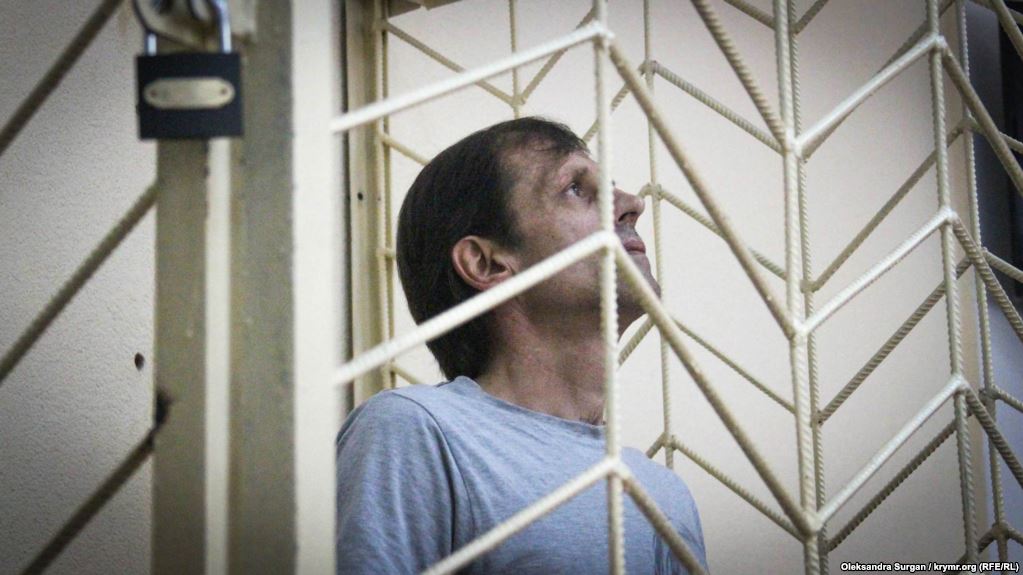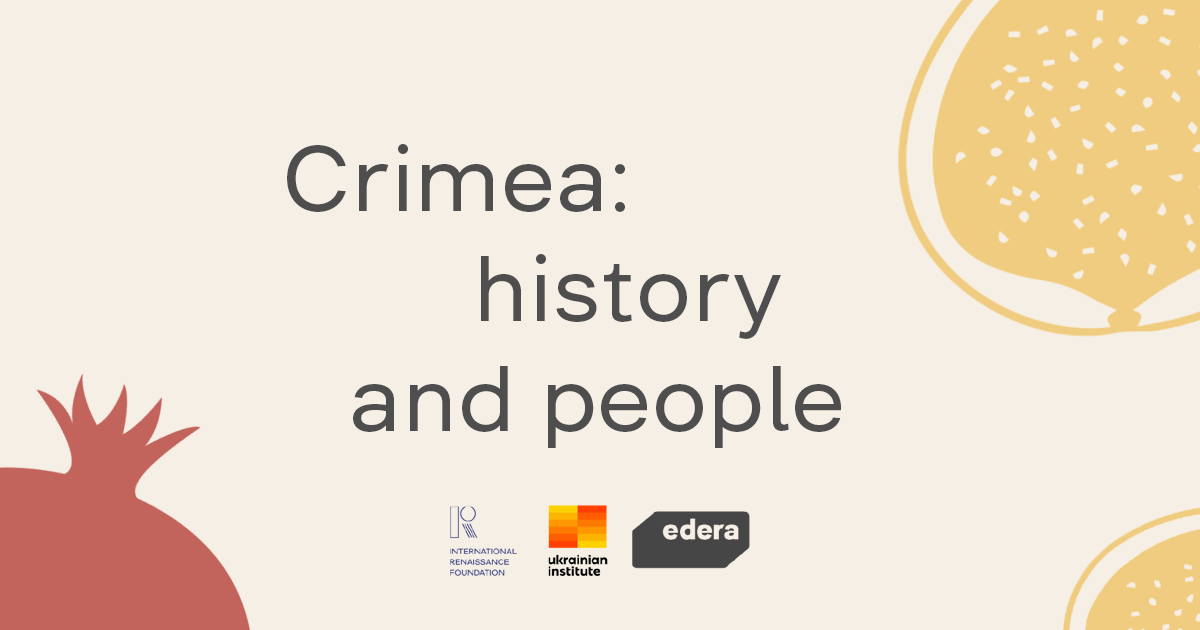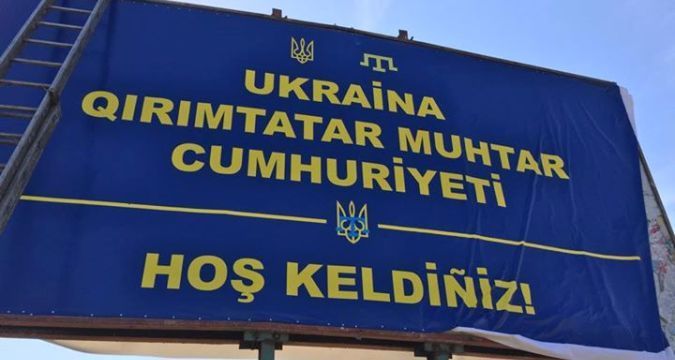Confused about events in Ukraine? We don't blame you. The protests started when then-President Yanukovych declined to sign the Association Agreement with the EU at the end of November 2013 and escalated into a de-facto revolution that left a hundred dead. Immediately after, Russia started a stealthy annexation of Crimea and takeover of South-Eastern Ukraine. The latter, being unsuccessful, has led to a frozen conflict in Donbas with which Russia hopes to continue to destabilize Ukraine. Physics teacher Borislaw Bilash guides us through the chronicle of newest Ukrainian history.
For great tips and ideas to teaching about events in Ukraine from Euromaidan onward, see his primer for teachers, a guide for educators teaching about events in Ukraine.
In November 2013, President Viktor Yanukovych announced that Ukraine was suspending pursuit of the Ukraine-European Union Association Agreement for which the country had been preparing for since 2008. The announcement led to the largest peaceful protests seen at the Maidan in Kyiv since the Orange Revolution of 2004. On November 30, 2013, at 4:00 a.m., as the protests dwindled, the Berkut Special Police forcefully dispersed a few hundred student-aged protesters who remained at the square, beating some with truncheons. The reaction of the public in response to the attack was momentous. The public would not stand by passively as their children were beaten. 10,000 people occupied the Maidan later that day. Another ten thousand travelled from Lviv, a city in Western Ukraine to protest Kyiv. By December 1, 2013, approximately 800,000 people had gathered at the Maidan. The assembled were less focused on the EU Agreement and more on anti-corruption. The crowd demanded the resignation of president Yanukovych.

As the days went on, more people from all corners of the country arrived in Kyiv. There was no single leader organizing the protest. In all, upwards of forty grassroots groups spontaneously came together having identified with each other and rallying around a common goal: it was time for Ukraine to rid itself of corruption. A city of tents was erected in the Maidan and along the streets leading to it (see photos here). People organized themselves into subunits, mainly based on areas of Ukraine from where they came. A perimeter was established with barricades erected to keep the Berkut Police at bay. A self-defense patrol called Samo-borona was established, its rules and discipline were based upon the Kozak (“Cossack”) traditions of Ukraine. It was widely believed that at the time, there was no safer place in Ukraine than the Maidan. A large stage similar to one used at rock concerts was erected in its center. The stage was active 24 hours a day. Every day after work hours, people gathered to hear the speeches of community activists as well as politicians who supported the movement. Musical & cultural artists kept the crowd entertained and in good spirits day and night. The largest crowds numbering in the hundreds of thousands gathered every Sunday afternoon.
In the early weeks of these protests, the government attempted to forcefully disperse the crowd but to no avail. The more the government pushed, the more people would show up to push back. The government paid street hooligans, called “titushkas”, to attack protesters, kidnap activists and journalists and create general chaos throughout Kyiv, while the corrupt police turned a blind eye to these hooligans.
In mid January, at Yanukovych’s demand, the corruption-laden parliament rammed through a series of anti-protest laws that came with severe penalties, making the country a de facto dictatorship. For example, the penalty for blocking the entrance to a government building during a protest was six years in jail. The laws were nearly identical to those introduced in Russia after the Bolotnyana Protests of 2012.

Three politicians emerged as the main interlocutors that negotiated on behalf of the protesters on the Maidan with President Yanukovych to end the standoff. They were: Arseniy Yatsenyuk, Vitali Klitschko and Oleh Tyahnybok. Their function in the crisis was unique. The crowd did not consider the trio their leaders. Instead, the three adopted the role of messengers between the Maidan and President Yanukovych. Each negotiation was considered fruitless, especially due to the fact that the foremost demand of the protesters was for Yanukovych to resign and he would not. Parallel negotiations between the Yanukovych government and European and US diplomats also took place with similar results.
The anti-protest laws infuriated the population, leading to a group of protesters to march out of the Maidan in the direction of the Parliament on 19 January 2014. These protesters were met on vul. Hrushevskoho street by the Berkut Police, transforming the peaceful Euromaidan protest into the infamous vul Hrushevskoho Riots. Following the killing of the first protesters by shots fired by the Berkut Police, negotiations continued and some of the anti-protest laws were rolled back. More negotiations and mass rallies continued through the month of February. But as before, what President Yanukovych offered was all but rejected by the Maidan. Protesters and activists continued to be kidnapped and murdered by government agents and Titushkas.
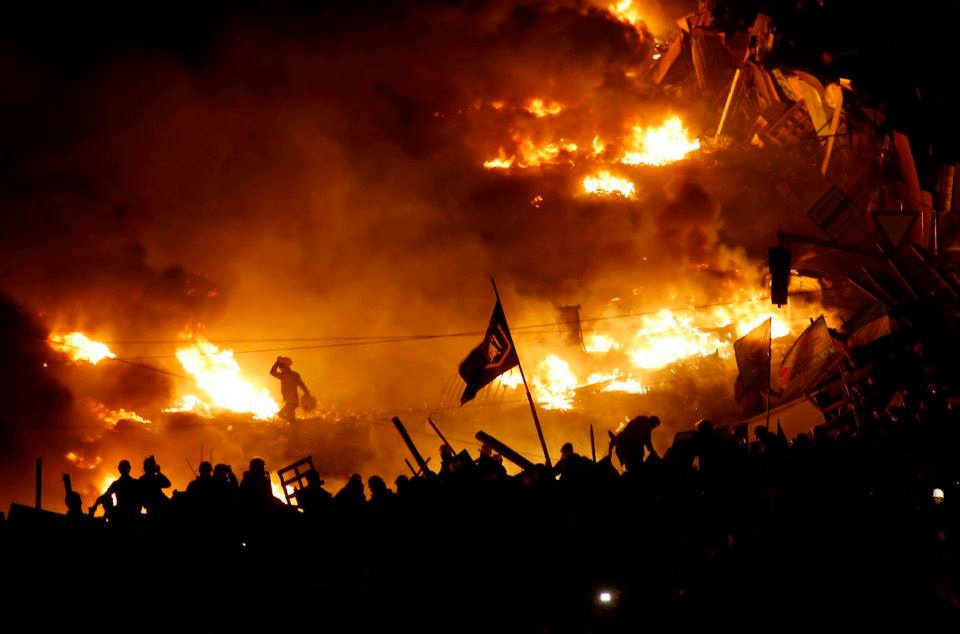
The stand-off grew increasingly tense as the world was preoccupied with the Olympics taking place in Sochi, Russia. It was widely believed that Russia had a strong hand in whatever was occurring in Ukraine following its independence in 1991. For this reason, there was concern that once the Olympics were over, Russia would overtly intervene in the crisis.
In the third week in February, protesters began a peaceful march through the streets of Kyiv but were met by Berkut officers throwing stun grenades and firing at them from rooftops. Berkut officers and Titushkas beat protesters with truncheons. More protesters were killed. The bloodiest day of the protests occurred on February 20, 2013, when government snipers perched on rooftops shot and killed 67 protesters who were armed with wooden clubs and shields made from sheet metal or wood. The massacre was filmed by professional and amateur journalists and widely distributed on the Internet. In all, more than 100 protesters died at the hands of the government and thousands more were injured. President Poroshenko claims there is evidence that Putin’s aid, Vladislav Surkov organized and directed a team of foreign snipers that killed the protesters on the Maidan. By February 22, the shock created by that bloodshed had prompted a mass defection by the president’s allies in Parliament and prodded Yanukovych to join negotiations.
Read also: My Maidan. A tribute to the revolution that changed us forever
President Yanukovych, European diplomats and the interlocutors of the Maidan scrambled to draft an agreement that would put an end to the crisis. Instead of resignation, the agreement included a clause that would accelerate the date of the next presidential election. The agreement was angrily rejected by the crowd gathered at the Maidan mourning the lives of the “Heavenly Hundred,” as those who perished are now known. An ultimatum was declared giving Yanukovych until morning to resign. Meanwhile, his own security cameras recorded Yanukovych packing up his estate in preparation for fleeing the country. Once it was discovered that Yanukovych had fled, parliament was called into session and formally removed him from office. Parliament then meticulously proceeded to reorganize the cabinet, with votes being unanimous or nearly so. Parliament appointed Oleksandr Turchenov was as acting president while Arseniy Yatsenyuk was appointed prime minister. Parliament voted to revert to the 2004 constitution, with Ukraine as a parliamentary republic, in which the prime minister and the parliament had more power than the president. New presidential elections were called for May 25, 2014. The Euromaidan Protests are now known as the Revolution of Dignity as it was always about ridding the nation of corruption.
A brief timeline of the protests is below (source). You can also take a test to see how well you know the history of Maidan!
Crimea, a strategically located peninsula on the Black Sea, is an autonomous region of Ukraine. It has special status granting home rule. It also has a large ethnic-Russian population as a result of the encouraged settlement of ethnic Russians on Crimea following the ethnic cleansing of the local population. This repopulation extends back to the time of Catherine the Great. Particularly harsh were the actions of Joseph Stalin in the 1940’s, who forcibly deported the entire population of Crimean Tatars from their ancestral land of Crimea.
The ethnic-Russian population in Crimea is bolstered by Soviet/Russian military officers who have traditionally found the peninsula an attractive retirement location. The port city of Sevastopol also serves the home of Russia’s Black Sea Fleet, as the result of a lease agreement between Ukraine and Russia. Ethnic Russians make up 60% of the population whereas ethnic Ukrainians make up 24%. Although the ethnic Russians in Crimea are citizens of Ukraine, many maintain a heart-felt allegiance to their ancestral roots. During every local and national political campaign since Ukraine’s independence, voters in Crimea tended to overwhelmingly support Pro-Russia candidates and policies. The Ukrainian parliament has always acknowledged the complex and unique nature of Crimea. For this reason, Ukraine’s constitution provides Crimea with a special status as an autonomous republic but as a inseparable constituent part of Ukraine.

On February 26, 2014, a week after President Victor Yanukovych fled Ukraine, armed men in uniforms without identifiable insignias began taking control of checkpoints and government buildings in Crimea. The identity of these armed men was initally a mystery. The next day, they ousted the Crimean prime minister, hoisted the Russian flag on top of Crimea’s parliament building and declared Sergey Aksyonov, a known criminal, the new prime minister. More armed men in uniform lacking insignias– now referred to as “little green men,” began appearing. The interim government in Kyiv was caught by surprise and reacted cautiously or not at all. World leaders voiced their concern but took no action. The Ukrainian military was ordered by their generals to stay on their bases and not to engage the armed men.
Under the supervision of these armed invaders, Aksyonov oversaw a vote of no confidence in the new government in Kyiv and subsequently called for a referendum. The ballot included only two choices: A] Join Russia or B] Return to the Crimean Constitution of 1992, giving Crimea a sovereign status, effectively severing itself from Ukraine. Voters were not given the choice to vote for status quo.
The vote took place on March 16, 2014, less than three weeks after the armed men appeared.
The process was highly suspect, as organizers purportedly printed ballots as needed on computer printers and there was evidence of ballots being pre-filled. The vote had to be carried out without verified voter lists as they were not made available by the Ukrainian government in Kyiv. Observers from Russia as well as right-wing groups from around the world sympathetic to the Kremlin supervised the poll. Western observers such as the OSCE or ODHIR did not send missions. According to the referendum organizers, 83% of registered voters took part in the plebiscite. Of those, 93% percent voted to unify with Russia, a figure many find suspicious. Most of the world’s countries have not recognized the results and condemn the referendum as a breach of the constitution of the sovereign nation of Ukraine.

Russia moved swiftly in its recognition of Crimea’s separation from Ukraine. The day after the referendum, Aksyonov asked the Russian Federation to admit the Republic of Crimea as a new subject with the status of a republic. Later that day, President Putin signed a decree recognizing Crimea as an independent state. The next day Putin and Aksyonov signed The Treaty on the Incorporation of Crimea into Russia. The Russian Parliament ratified the treaty a few days later. In less than one month, Crimea went from being an integral part of Ukraine to a subject of Russia.
Most countries and extra-national bodies of the world consider the absorption of Crimea by Russia as an illegal annexation of Ukrainian territory. Russia has been accused of orchestrating the Crimean crisis and Vladimir Putin has since admitted that the mysterious “little green men” were indeed his own. In fact, Putin has stated that Russia's intervention was necessary "to ensure proper conditions for the people of Crimea to be able to freely express their will."
In response, the G-8 nations expelled Russia and the European Union, Canada, the United States, as well as other nations, imposed various sanctions on Russia and on certain individuals associated with the annexation. Russia has been accused of violating the Budapest Memorandum, of which it is a signatory, which guarantees Ukraine’s sovereignty and territorial integrity. Many have suggested that the United States and Great Britain, as co-signatories of the Budapest Memorandum, have skirted their responsibility with respect to their role in upholding the agreement.
Since annexation, Crimea has experienced a significant еconomic downturn and erosion of human rights. Tourism has decreased significantly. The economy of this Black Sea peninsula relies heavily on tourist spending.
Prior to annexation, the Crimean coast was one of the top 20 travel destinations in the world. Consumer products are no longer sent from the mainland of Ukraine and Crimeans must now rely on imports from other sources. Non-ethnic cultures, in particular Tatars, complain of repression. All religious communities except the Moscow patriarchate of the Russian Orthodox Church face difficulties. Libraries have been cleared of books written in the Ukrainian language, which have also been burned in public.
A brief timeline of the annexation of Crimea is below (source):
Learn more at our special project dedicated to Crimea.
Within a week of President Yanukovych’s departure in the early morning of February 22, 2014, pro-Russia protests sprouted in major cities in eastern and southern Ukraine. \Russian television broadcasted into Ukraine told stories of Ukraine having been overthrown by a Western-sponsored “Kyiv fascist junta,” Kyiv being in turmoil and Russian speakers being under threat of having their rights stripped and even being killed. All this occurred while the “little green men” of Russia were in the process of annexing Crimea and the country was preparing for presidential elections. These rallies were much smaller than those seen during the Pro-Ukraine Euromaidan protests
. In many cases, the organizers and participants were citizens of Russia, not Ukraine. Russian social media groups, including some on Vkontakte, offered to pay people to go to Ukraine to participate in such protests. Busloads of Russian citizens were transported from Russia into the cities of Luhansk and Kharkiv, which are close to the Russian border. In the provinces of Luhansk and Donetsk, armed militants managed to overtake and occupy government buildings and take control of television and radio transmission towers. Chaos ensued in eastern Ukraine. From April through June 2014, militants expanded their captured territory.
In response, volunteers began forming battalions that fought back the militants, after which the Ukrainian government created an Anti-Terrorist Operation (ATO) that attempted to take control and suppress the terrorists.
The militants, calling themselves Pro-Russia separatists, continued to seize buildings, overtake smaller cities in the provinces of Donetsk and Luhansk and wage battles with government forces. Many of the militants were Ukrainian citizens with combat experience, having served in the Russian Armed Forces. In all, about two thirds of the militants were Ukrainian citizens. Igor Girkin, known by his nom de guerre as Strelkov, coordinated the efforts of the militants.
Girkin was later identified as a colonel in Main Directorate of the General Staff of the Armed Forces of the Russian Federation (GRU). Anti-Ukraine propaganda escalated on Russian-language television, the only media that the militants made available in eastern Ukraine.

The militants staged two referendums – one in the province of Luhansk in late April, and another in the province of Donetsk in early May – that were similar to the one conducted in Crimea. Subsequently, they declared two independent states: the Donetsk National Republic (DNR) and the Luhansk National Republic (LNR).
Both stated that unification with Russia was their goal. The prime minister of the DNR was Alexander Borodai, a Russian national later identified as an employee of the FSB. The prime minister of the LNR was Valery Bolatov, also a Russian citizen. In August 2014, when it became well known that these individuals were Russian citizens, both resigned and were replaced with Ukrainian citizens.
The Ukrainian government continued their ATO as the militant-terrorists continued to escalate their attacks and take more territory under control in eastern Ukraine. The presidential elections took place without incident on May 25, 2014, but about one third of the regions in the provinces of Luhansk and Donetsk could not take part in the election as they were under pro-Russia terrorist control.
Soon after taking office, President Poroshenko proposed a 15-point peace plan that called for an immediate ceasefire in exchange for decentralization of political power, reconstruction of the area, and more. Soon after agreeing to the ceasefire the militants, shot down a military helicopter in Sloviansk.
Numerous battles were fought across eastern Ukraine during the months of June and July 2014. Evidence began surfacing that terrorists were using military hardware that could only have originated in Russia. In July, the terrorists have been accused of shooting down a Malaysian Airlines plane carrying 298 civilians from Amsterdam to Kuala Lumpur, thinking it was a Ukrainian military airplane.
The incident directed the attention of the world to what was happening in Ukraine. Investigations later confirmed that the airliner was shot down using a Russian made BUK missile system, a sophisticated anti-aircraft weapon. The missile system required specialized training to operate as well as the support of ground-based radar – the nearest of these being available on Russian soil.
In addition, the US State Department and independent investigative journalists have provided evidence that Russian ground forces have repeatedly fired into Ukraine from the Russian side of the border.
Read also: Seven reasons the conflict in Ukraine is actually a Russian invasion
As August approached, it became clear that Ukrainian forces were pushing back the terrorists and it seemed that the conflict would soon be over. Meanwhile, Russia announced that it was sending a convoy of 280 tractor-trailers of humanitarian aid into the warzone.
The Ukrainian government required that the trucks be inspected by the Red Cross prior to entering the country. Russia refused and entered without authorization. Shortly after the delivery, the fighting escalated as if the terrorists were now reinforced. On August 29, a battalion of Ukrainian soldiers were besieged in the town of Ilovaisk. President Putin called for a humanitarian corridor to be established so that the soldiers could withdraw from the area peacefully. Instead of allowing the soldiers to leave as agreed, the terrorists opened fire leaving over 300 dead and capturing another 500.
In early September, extensive diplomatic negotiations involving the OSCE, Ukraine, Russia, DNR and LNR led to an agreement known as the Minsk Protocol. The 12-point agreement called for an immediate ceasefire, establishment of a buffer zone, exchange of prisoners, release of hostages, and decentralization of power, and resolution of other points of contention.
It was a ruse, designed to allow the terrorists to continue their aggression and continue expanding their territory, while Russia continued the delivery of munitions under the guise of humanitarian aid. For the most part, Ukrainian forces maintained a defensive position and refrained from engaging the terrorists in offensive battles. By January, the terrorists had increased the territory they control by 30%, and thousands of civilians and soldiers were killed. Ukrainian-controlled cities outside of the conflict zone are being shelled by Russian forces, killing civilians. Terrorist attacks are taking place in cities all around Ukraine.
Russia has repeatedly denied the presence of its military forces in Ukraine. It claims that any Russian citizens fighting in Ukraine are there of their own accord, including some who have been granted temporary leave from Russia’s armed forces. Human rights groups in Russia claim that many young soldiers, upon concluding their 1-year mandatory military service, are subsequently duped or coerced into continuing their service and end up fighting in eastern Ukraine. Satellite images released by the US military, as well as the passports and military IDs of captured soldiers, confirm that Russia’s military is indeed active in Ukraine.
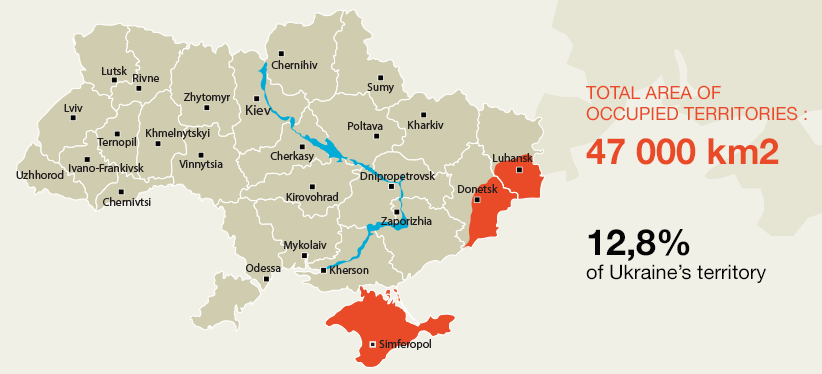 As evidence of Russian intervention continued mounting, the European Union, Canada, the US and other nations imposed sanctions on Russian political and business leaders in the hope that this would persuade Russia to cease its operations in Ukraine. Since September 2014, American and European leaders have been engaged in the debate over whether or not to arm Ukraine with lethal weapons.
As evidence of Russian intervention continued mounting, the European Union, Canada, the US and other nations imposed sanctions on Russian political and business leaders in the hope that this would persuade Russia to cease its operations in Ukraine. Since September 2014, American and European leaders have been engaged in the debate over whether or not to arm Ukraine with lethal weapons.
To date, the support given by the United States has been limited to intelligence information, night-vision goggles and blankets. In his address to the US congress, the Ukrainian president stated that this war cannot be won with blankets. Many argue that providing Ukraine with lethal arms would give the Ukrainian armed forces a fighting chance at repelling forces supplied by the Kremlin. In contrast, US President Obama and German Chancellor Merkel have repeatedly stated that there is no military solution to this conflict, but that pressing on with more sanctions would eventually pressure Russia to end its encouragement of the dismembering of Ukraine.
In February 2015, the leaders of Ukraine, Russia, France and Germany signed an agreement known as Minsk II Protocol.
The measures were nearly identical to those first proposed by Poroshenko in June 2014, and later repeated in the first Minsk Protocol of September 2014. The Minsk II Protocol was signed on February 12t and stipulated that the ceasefire would commence at 00:00h on February 15.
Read more: 12 months of Minsk-2. Examining a year of violations
While the negotiations took place, in which Putin participated, Russia continued sending heavy armaments into Ukraine. Russia denies this, but satellite imagery proves otherwise.
The shelling on the day before the ceasefire came into effect reached an all-time high. During the time of negotiations, the Ukrainian forces were defending the strategic town of Debaltseve. They were severely attacked by the Russia-supported terrorists. The terrorists claimed that they did not consider Debaltseve to be in control of the Ukrainian forces and thus exempted from the treaty.
A few days after the agreed-but-constantly-violated ceasefire, while enduring heavy battles and being caught in an offensive cauldron, Ukrainian forces retreated from Debaltseve.
Curretly, Russia is attempting, with the help of Western countries, to pressure Ukraine into fulfilling clauses of the Minsk agreement that would allow to destabilize it from within.
A brief timeline of Russia's hybrid war in Donbas is below (source):


